Cybersecurity + Biomimicry: Why, What, and How We Could Learn from Nature

Biomimicry is innovation inspired by nature. It is an emerging discipline that enables people to solve the problems in different areas by looking to the natural world for inspiration. Cybersecurity is not an exception. Patterns found in nature and strategies used by different organisms could be applied to develop effective defensive techniques in cybersecurity.

"What nature has to teach is more than we have ever imagined."
John Lanie
Why
When it comes to problem-solving, there are a lot of reasons why we should ask nature first.
Nature is much older than we are
Life on Earth started its journey nearly 3.8 billion years ago [7]. Nature has to face the same problems that we do, but it has much more time to «run experiments» in its «labs» all over the world to find sustainable and energy-efficient solutions.
Biomimicry helps reasoning
There are several theories trying to explain how reasoning happens. According to the "Mental model" theory, the reasoning is a visuospatial process and happens with the help of images and logical terms of our language ("and", "all", "if", etc.) [1]. Having an image is one of the cornerstones of reasoning.
Biomimicry deals with different organisms, their structures and systems that may have a clear visual representation. So biomimicry helps get that image that enables the thought process.
Biomimicry is a natural way of learning
Biomimicry got integrated into many areas of our life (think of velcro, turbine blades, bullet trains, needles, motors, and aircraft). Whether conscious or not, people are using it these days to solve different problems. And there is a biological reason why this happens.
Our behavior is shaped by the environment/context we are surrounded by. We learn from this environment, which initially was just nature. In 1961, Albert Bandura showed that people could learn by imitating the behavior of other organisms. Think of Kung Fu fighting styles modelled after animals, for example. The physiological basis for this phenomenon is mirror neurons found in our brains [2, 3].
So, we can integrate behavioral patters/strategies found in the biosphere into our own behavior, as into anthroposphere.

What

Nature's unifying patterns
If we take all chairs in the world and analyze them, we will be able to see some common characteristics / unifying patterns (four legs and a surface). This can be achieved with the help of abstraction (specific examples → general rules/aspects).
Just like that, if we analyze nature and the interaction and functioning of different organisms, we can identify some unifying patterns/design lessons (nature runs on information, seeks to recycle all materials, uses materials harmless to the environment etc.) [7].
These are the patterns we need to consider during any biomimicry design process (section «How» of the article) to get more sustainable solutions.
PROTECTION framework
In order for living organisms to survive, they need to adapt. It is the key. It allows them to evolve. There are several characteristics/patterns that ensure adaptability, namely: responsiveness, heterogeneity, decentralization, redundancy, and cooperation. These five features form the PROTECTION framework (resPonsiveness, heteROgeneity, decenTralization, rEdundancy, and CooperaTION) [4].
Let's take a closer look at them with some examples:
Responsiveness
It is the ability to respond to changing conditions (think of reflex arcs that allow our body to react almost instantaneously to some stimuli like a hot surface).
Heterogeneity
The more variants of genes an organism has, the better its chances are for survival.
Heterogeneity is also about the role differentiation/specialization in the population (think of ants colonies).
Decentralization
It is about the distribution/diversification of control and localizations (think of bees, for example).
Redundancy
It is about the allocation of an excessive amount of resources for some purpose (think of lizards shedding their tails, when critical events happen).
Cooperation
Think about lichens (algae / cyanobacteria + fungi collaboration for the mutual benefit).
Biomimicry found its place in different areas of computer science (including cybersecurity). For example, there are a lot of nature-inspired computational algorithms and even frameworks for application development inspired by cells.
As for cybersecurity, there are a lot of terms inspired by nature ('virus', 'worms', 'infection', 'epidemic'). The aforementioned patterns are widely used in cybersecurity. They allow improving its overall effectiveness [4].
«Cyber-predators» and «cyber-prey»
When it comes to cybersecurity, there are two types of entities, just like there are predators and prey found in nature: the first one («cyber-predators») uses offensive techniques, and the second one («cyber-preys») uses defensive techniques.
To survive, both parties need constantly to adapt to changing conditions and evolve, just like living organisms. It is ensured by the aforementioned PROTECTION patterns.
Let's take a look at some examples of these entities and their analogs in nature:
«cyber-predators»
Cybersecurity:
SPAM
Nature:
Small Balsam (Impatiens parviflora)
Pattern:
Generation of large volumes of needless materials (redundancy)
Explanation:
Just like SPAM is about a generation of unwanted (for the target audience) resources, the Small Balsam proliferation strategy is about spreading its seeds that get catapulted at high speed and at the slightest touch once they are ripe. The latter makes it an unwelcome guest in different ecosystems, as it has a negative effect on biodiversity [5].
«cyber-prey»
Cybersecurity:
Systems sacrificing their parts or information to save themselves as a whole
Nature:
Lizars
Pattern:
Sacrificing parts to save the whole entity (redundancy)
Explanation:
Just like lizards shed their tails to save themselves as a whole organism, there might be information/systems that get sacrificed in order to save the «cyber-prey». This way, the cyber-prey can better understand who the "cyber-predator" is and take the actions needed to improve its infrastructure [5, 6].
Functions and strategies
We need to understand two basic concepts to master the art of biomimicry.
As mentioned above, the key to survival is adaptability. Strategies are organism'’ adaptations (behavior, mechanism, process, or property) used for specific purposes (functions). Achieving the latter is what allows the organism to survive. Functions are also goals that your design solution needs to achieve [7].
For example, Pharaoh ants (Monomorium pharaonis) use special pheromones as a mean of communicating information about rewarding routes to the collective benefit of the whole colony. In this case, laying trail pheromones is a strategy. It is used by ants to coordinate their activity. The latter purpose is a function. As for cybersecurity, there are "di” monitor systems for different anomalies. They mark these places, just like Pharaoh ants do. Then, this information can be used to alert cybersecurity specialists [6].
Another example would be chameleons that can change their color. Modifying color is a function. This purpose is achieved with the help of the aforementioned structures. The usage of the latter is a strategy. As for cybersecurity, sensitive data can be concealed so that they look like something else (images, audio files etc.). The practice is called steganography [6, 7].

It's a new way of inventing by looking to the natural world for inspiration, and asking, before we design anything, "What would nature do here?"
Janine Benyus
How
Let's talk about the sources for information and inspiration.
Use the knowledge that you already have
Whoever you are, there are high chances that you have been interacting with nature, reading books and watching movies about it since birth. It is hard to escape nature. So, the knowledge you need may already be in your head. Use it.
Just go outside, observe nature, and practice
Try to be a naturalist and use / trust your senses. Think about the functions and strategies your design solution may need and try to identify them. You can make notes in a nature journal. The best way to learn biomimicry is through practice.
Use AskNature
Biomimicry is about asking, "How would nature do this?". AskNature is an innovative match-making service developed by the Biomimicry Institute, a web tool/database that may help you to get the answers. It is a great source to start your journey in the world of natural models and strategies, which are organized by the functions they serve.
Explore scientific literature (in print and online) and watch scientific documentaries
Search for scientific journals, magazines, and articles with the help of the internet or libraries. Scientific documentaries are also a great source for inspiration.
Ask biologists, naturalists, and biomimics
If you can not find the answers needed inside of you or in nature around you, try talking to people who may have them. You can also use your computer and try talking to specialists on online forums [7].
The biomimicry design process
In order to develop your design solution, it is a good idea to follow an organized sequence of steps (biomimicry design process):
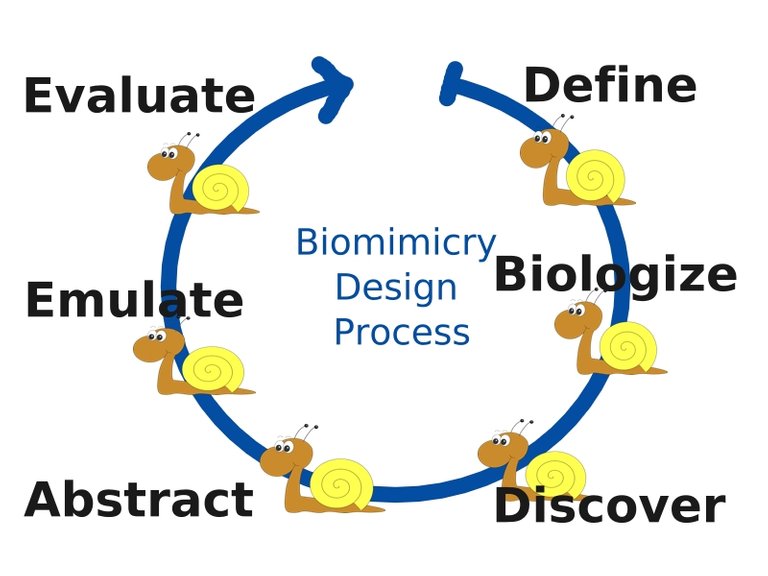
Let's try to develop a model/concept of an anti-virus system for computers inspired by nature with the help of AskNature.
Let's go through the aforementioned steps with our design challenge in mind.
Define
This step is about understanding our design solution's purposes and the context it will be in. It is about asking the “How might we…?” question. So, “How might we defend effectively computers from viruses?” The purpose of our design solution is to defend the devices from computer viruses. Protection from computer viruses (not DDoS attacks or SPAM campaigns) is what is the context.
Biologize
Now, we need to move into a biological context. This step is about paraphrasing the question asked in the previous step in biological terms. Here, we need to ask, "How does nature…?" questions. Let's try with "How does nature defend itself from toxic chemicals/pathogens?".
Discover
This step focuses on research and information gathering. It is about searching for biological models (organisms and ecosystems) and strategies needed to solve specific design problems. This is where AskNature comes into play. Let's visit AskNature website and click on "BIOLOGICAL STRATEGIES" (top center). Then we need to click "SEARCH STRATEGIES" (center). The web page we got is where we can search for strategies now:
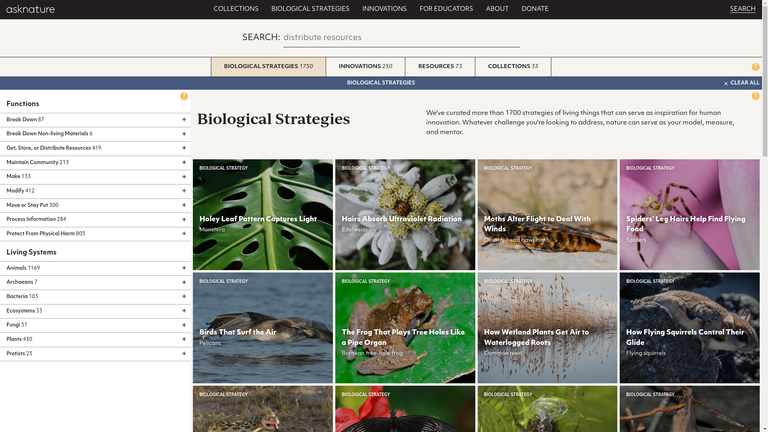
As mentioned before, strategies are organized by functions. So, we can either navigate the tree of functions, or we can just enter keywords relevant to our design challenge into the search box (top). Let's try the first option. Click on the "Protect From Physical Harm" element; then we choose "Protect From Non-living Threats". After that, we click on "Protect From Chemicals":
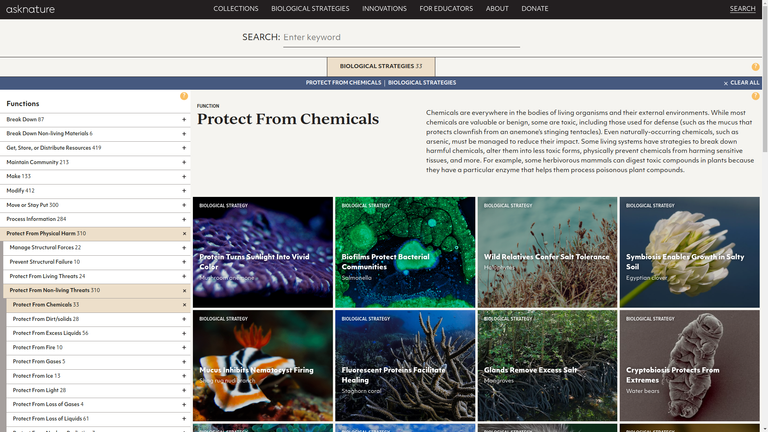
Now, as you can see, we have many strategies. Let's navigate to the bottom of the page and choose the following ("Defensive Measures Prevent Toxicity of Heavy Metals"):
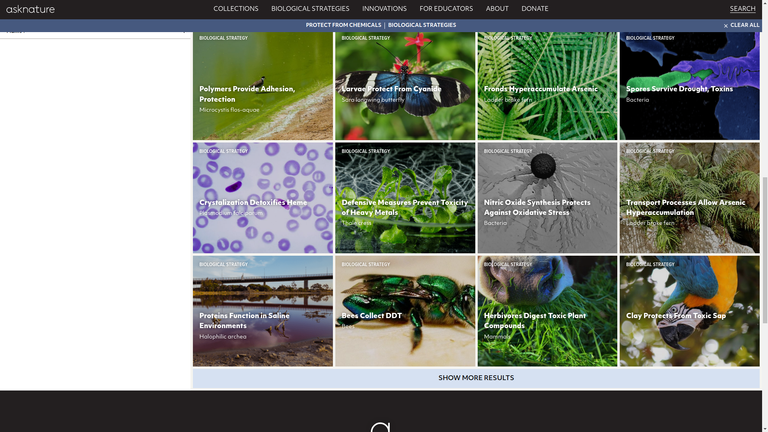
We can also find this strategy with the help of a search field by entering relevant keywords (like "defensive measures", "protective measures", "toxic chemicals", "security measures" etc.):

Now, let's click on the aforementioned strategy to get more details:
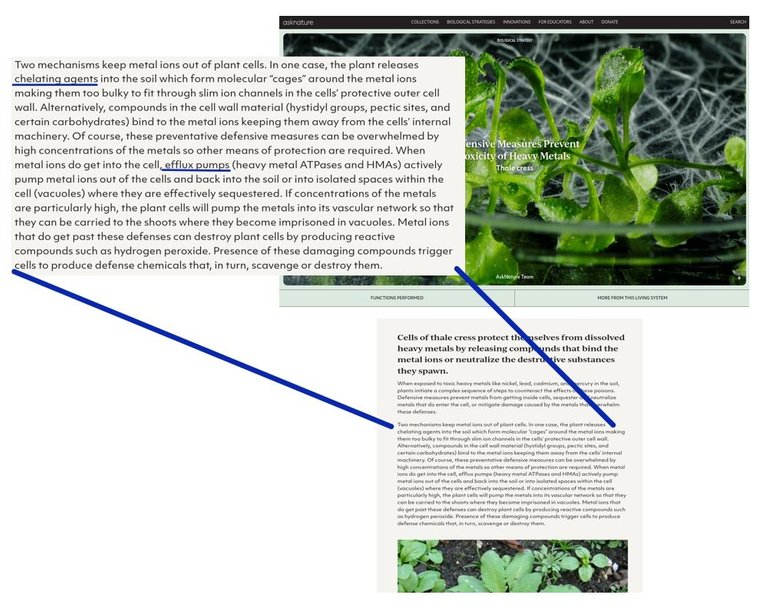
Basically, there are two lines of defense used by Thale cress to protect itself from toxic elements (see the image below):
a) the plant can release molecules that bind to toxic chemicals (d) outside the cell and make them too large to enter into the cell via channels;
b) if the chemicals get into the cell, then special pumps/channels in the cell wall/membrane can pump the toxic metal ions (d) out of the cell, where they can be blocked by the aforementioned mechanism;
These mechanisms can be illustrated like this (image 1 / left side):
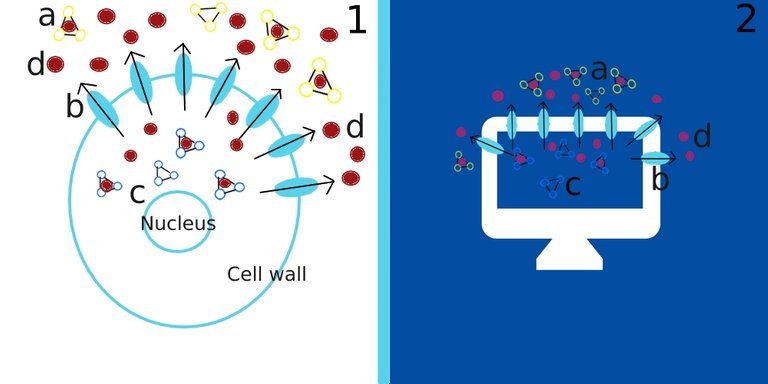
Abstract
This step is about abstraction, moving from specific examples to general rules/principles/aspects. Here, we need to describe the strategy without using biological terminology. We need to summarize the strategy and "extract" the most essential features and mechanisms that enable this strategy to do its job so that we can apply them to our design solution.
When exposed to a threat, a "prey" initiates an appropriate immediate response (responsiveness). Using two different (not identical) lines of protection increases the chances of successful defense (heterogeneity). Two defense mechanisms work in different places (decentralization). Two (not one) systems are used to ensure the reliability of defense mechanism (redundancy). Two lines of defense work in conjunction (cooperation).
As you can see, this strategy corresponds to the requirements set by the PROTECTION framework, which enables the adaptability of the organism that uses it and ensures its survival. Just like that, this strategy should allow specialists to create an effective anti-virus system that will help computers adapt and survive the viral attacks (image 2 / right side).
Emulate
Now, we can use the "recipe" we got in the previous step to develop design concepts.
Evaluate
This step is about assessing the design concepts we got. We need to figure out whether or not our design concepts meet the criteria/goals we set at the beginning of the biomimicry design process. Previous steps can be revisited if needed to improve the solution [7].

Conclusion
Biomimicry can be applied in different fields (including cybersecurity). We are surrounded by nature-inspired innovations, whether we realize it or not. Applying nature's genius/lessons in our life is an inescapable result of human nature.
We could consider our nature not just like a source of resources, but as a source of wisdom, as our teacher. So, why would we destroy our nature if we could learn from it so much? I believe it is biomimicry that could allow us to thrive on Earth.
I want to leave you with this final thought. Whenever you have a problem in your life, don't panic, you have a good friend. Ask Nature first.

The headline image was composed by me with the help of the lizard, chameleon, ants, network, globe, and mouse images. Other images sourced from Pixabay.
The divider was created by me with the help of the globe image.
Screenshots sourced from AskNature website. All screenshots are used under the doctrine known in USA as “Fair Use“ (similar doctrines are used in other countries).

Reference
- Goel V, Buchel C, Frith C, Dolan RJ. Dissociation of mechanisms underlying syllogistic reasoning. Neuroimage. 2000;12(5):504–514. doi:10.1006/nimg.2000.0636
- Bandura and Bobo
- Keysers C. Mirror neurons. Volume 19, ISSUE 21, PR971-R973, November 17, 2009
- Rzeszutko, Elzbieta & Mazurczyk, Wojciech. (2014). Insights from Nature for Cybersecurity. Health security. 13. 10.1089/hs.2014.0087.
- Mazurczyk, Wojciech and Elzbieta Rzeszutko. “Security--A Perpetual War: Lessons from Nature.” IT Professional 17 (2015): 16-22.
- Cybersecurity and Biology: Biomimicry and Innovation Inspired by Nature
- BIOMIMICRY TOOLBOX
Thanks for your contribution to the STEMsocial community. Feel free to join us on discord to get to know the rest of us!
Please consider delegating to the @stemsocial account (85% of the curation rewards are returned).
Thanks for including @stemsocial as a beneficiary, which gives you stronger support.
Thanks for sharing this article. It was educative
thank you for your kind words, it is cool to know that the information I try to share is helpful / interesting for people.
You're welcome